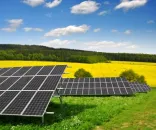
Here's what is expected of India's new power minister
Pricing of power must be on his to-do list, experts say.
In a major cabinet reshuffle recently, India’s erstwhile Minister of Power and Renewable Energy, Piyush Goyal, demitted office to become the new Minister of Railways. R.K. Singh, an erstwhile bureaucrat and now a Member of Parliament, has been appointed as the new minister.
According to Bridge to India, during the 40 months of his tenure, Piyush Goyal initiated important supply side reforms including allocation of coal linkages, increase in domestic coal production, solar parks policy and green corridors program. In this time, thermal power capacity has grown by 60 GW, renewable power capacity by 23 GW and transmission capacity by an aggregate of 25%.
Not accounting for latent power demand, these steps have turned India from chronically power deficit to a power surplus country.
Here's more from Bridge to India:
Surplus power situation, if not addressed through adequate demand side reforms, will affect renewable sector prospects. Rural electrification is unlikely to result in any tangible growth in power demand but may actually increase financial burden on DISCOMs.
The incoming minister’s priorities should be to rationalize pricing of power, enforce operational improvements in DISCOMs, deal with the ‘Make in India’ conundrum and improve investor confidence in the sector.
However, power pricing and demand side reforms have not kept pace. Despite UDAY scheme’s success in eliminating USD 36 billion of debt from DISCOMs and rapid electrification agenda, power demand has grown by a CAGR of only 4.5% in the last three years.
Thermal power plants are now operating at average PLF of less than 60% as against an expected 75-80%. Resulting stress is percolating to other parts of the sector including renewables where many tenders have been scrapped and PPAs face the risk of renegotiation.
The Finance Ministry has called for rationalization of renewable capacity addition and we believe that utility scale solar capacity addition will slow down over the next two years. Now, the government is moving to restrict open access market.
These quick fixes may help thermal IPPs and DISCOMs in the short-term, but are bound to hurt renewable energy prospects.
As the government pushes ‘Make in India,’ focus for the new minister should be power pricing reforms to make manufacturing more competitive and boost power demand. It is worth noting here that power tariffs for industrial consumers are higher in India than in many western economies.
Other pressing issues of the hour are anti-dumping duty petition for solar module imports and flagging investor confidence in the sector. Many leading international and Indian investors have entered this market attracted by large scale and strong government commitment. They need validation of their business strategy and reassurance that contracts will be duly enforced to protect their interest.













 Advertise
Advertise











